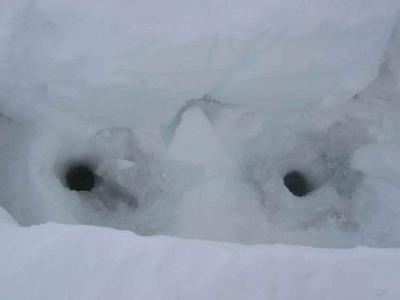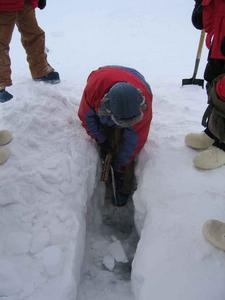14 October, 2003
Teachers and students know that there is a vast difference between listening to a lecture
describing how to do something and actually taking to the field to DO it. As a result of
yesterday’s ‘Condition 1’ Sea Ice School, we were asked to report one more time to go
out on the ice to apply the information we had been given. Could it be that they thought
we had been more interested in the Condition 1 blizzard raging outside, or distracted by
sitting in an unheated hut for 2 hours? In any event, our training group gathered this
afternoon to meet our FSTP (Field Safety Training Program) instructor for another trip to
the ice.
We learned yesterday that sea ice and ice crack evaluation combines scientific
observation and data collection with basic math. There’s a few ‘magic numbers’ to
remember. The US Antarctic Program has set thickness standards for safe travel across
ice cracks. The ice must be a minimum of 30” thick to be considered safe for travel. The
other numbers to consider relate to the vehicle you are driving. The safe travel standards
stipulate that if the ice is less than 30: thick, the effective width of the crack can not
exceed more than 1/3 of the vehicle’s track length or tire length that is in contact with the
ice. What does this mean? Well, if you are driving a snowmobile with a 60” track, you
cannot cross an area less than 30” thick if it is greater than 20” wide. We will be driving
snowmobiles and piston bullies—the piston bully’s track length is 108”. You could do the
math and determine what is the maximum safe effective width for travel. The other rule
for traveling across sea ice cracks might be ‘when in doubt, chicken out’. If it’s iffy it
seems to me it would be best to spend a little time finding a more convincing place to
cross. Remember—the ocean is cold and deep.
Another important, if not crucial part of sea ice travel is recognizing the cracks. Often they
are indistinct, hidden under a couple feet of snow. We were taught to look for visual
breaks in the ice or snow cover that would indicate some sort of irregularity. In addition,
you can look for sagging areas of snow that may be a different color or texture than the
snow around it. Best of all, perhaps, is to look for seals. Seals utilize ice cracks to
surface for air or to come out onto the ice. Areas with signs of seals such as seal scat,
urine, or even blood left from cuts in their mouths as they grind through the ice, are pretty
good bets for cracks. That means that we will be working in prime ice crack areas since
we are working with the Weddell Seals. Now, there’s another reason to pay attention
during Sea Ice Training!
This afternoon’s session took place on the ice within sight of McMurdo. Our mission was
to profile an ice crack known as ‘Big John’. It would be easy to overlook this crack in the
general white backdrop if you didn’t know what to look for—changes in the snow and,
when we looked carefully, we saw a depressed central area perhaps 10 feet across. This
crack is a consistent one in that area and is, in part, a result of the swirling ocean currents
under the ice near McMurdo.
Our first job was to dig a trench across the crack, clearing snow down to the ice. Then we
used an ice drill to create a profile of the crack, drilling at 20” intervals (pretending we
were driving snowmobiles with a maximum safe travel width of 20”) until we hit water. All
of us were given a chance to use the hand drill—and then we broke out the motor drive
to finish the 10 holes. Once holes were drilled we used a tape measure to determine the
thickness of the ice. At the edges of the crack it was over 30”, but in the middle it was
certainly less than that. The lesson here is, ‘when in doubt, check it out’. It is certainly
better to spend some time evaluating a suspect area than it might be to experience the
consequences of an unplanned Antarctic swim!
We are moving closer to getting out in the field. Today it was rumored that our huts
would be pulled out to field camp. Gillian, Darren, and Brent took a helicopter flight over
the study area this afternoon to see what was going on in the world of Weddells. They
saw about 30 seals and just a few pups. With a little luck and cooperation from the
weather and the people in charge of logistics we will be out at our field camp in a few
days.
Daily Haiku:
Hidden sea ice cracks
Move the snow, drill many holes
Is it thick enough?

Can you see the snow-covered crack in this picture?

Kelly digs a trench across the crack

Drilling the holes

Look for the slushy water in the holes

Measuring the thickness of the ice
Contact the TEA in the field at
.
If you cannot connect through your browser, copy the
TEA's e-mail address in the "To:" line of
your favorite e-mail package.
|
